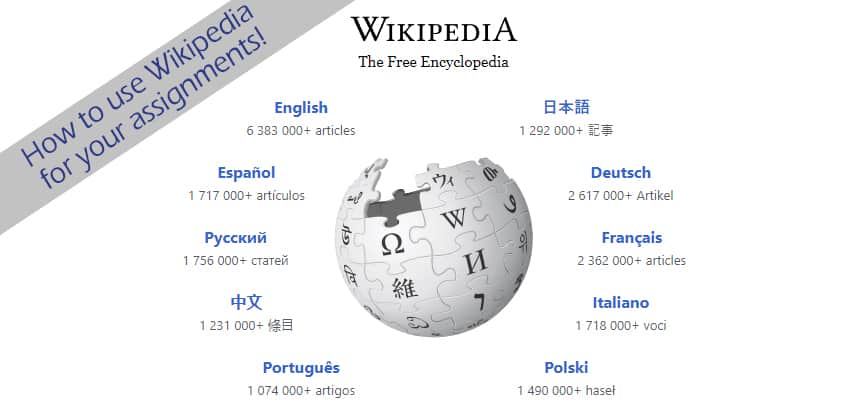Yes – absolutely.
Wikipedia is a great way to get started on your research because it has everything you need in one place. In fact, the main function of Wikipedia is to get an overview of a topic, rather than just a slice of it.
That’s why Wikipedia is one of the most visited websites on the internet. Apart from giving an introduction to unfamiliar topics, it can guide you to other (credible) sources for further reading. But nearly all universities and educators repeatedly tell students not to use Wikipedia for academic writing. Although this a fairly agreed upon ‘rule’, some rules are meant to be broken (without getting caught, obviously).
What we’re trying to tell you is to go about this wisely. To use Wikipedia for academic research even though it is not considered a reliable source, you need to look up the references that are provided within the article. You can run them through an academic database like Google Scholar while also assessing whether those references are credible on their own. Not sure how to assess the credibility of a site? We explain this in detail with a comprehensive checklist for website credibility evaluation specifically for students.
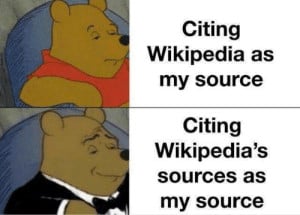
What does a credible site on academic writing guidelines have to say about this approach? You can read for yourself.
While it’s not encouraged to use Wikipedia as one of your main sources, Wikipedia can be used as a jumping-off point for other sources. At the bottom of most Wikipedia pages, you can find a list of sources that will take you to other pages…
Purdue Online Writing Lab
In order to use Wikipedia correctly for academic research, we first need to understand how Wikipedia works. This will give you a better idea of why it is considered unreliable and how you can overcome this.
Table of Contents
How does Wikipedia Work?
- Wikipedia is the largest web-based, free encyclopedia, compiled using the collective knowledge of internet users across the world. In short, Wikipedia articles are generated through ‘crowdsourcing’ – a termed coined (in June 2006), well after Wikipedia was established (in January 2001).
- Wikipedia’s crowdsourcing process involves a community of anonymous volunteers who collaboratively contribute to a topic. The information on that topic is then presented to the reader as a single article. To create a new page or introduce a new topic on Wikipedia, users need to be registered and signed-in. However, modifying and editing an existing page can be done by just about anyone. This is because the edits are linked to the IP addresses making the changes instead.
- The main concern on Wikipedia’s reliability can be understood by focusing on the authors contributing to Wikipedia pages. That is, the broad groups of people who write and edit Wikipedia articles need not necessarily be experts in the field, as everyone with internet access can add to Wikipedia’s content, including vandals and quacks. That’s why you are being cautioned to stay away from this site.
Why do educators say Wikipedia is not a reliable source?
Although various studies note Wikipedia to be reasonably accurate with current information and wide coverage of topics, the website is not considered a credible source for academic research. This is because from an academic perspective, Wikipedia articles are neither scholarly, nor peer-reviewed, and can contain:
- Biased information
- Misinformation
- Inaccuracies
- Factual errors
- Omissions of crucial information
These are some of the key factors based on which there is a widespread belief in academic circles that Wikipedia is not a reliable source.
How accurate is Wikipedia?
However, having mentioned the differences of Wikipedia from standard academic sources, it should be noted that the site does have countermeasures in place to address these.
To improve the accuracy of its content and ensure error-free articles, Wikipedia has put in place many preventive measures. These are supposed to make it difficult to add false information, although it is not impossible. Example of these measures include the following:
- Wikipedia articles are routinely monitored by moderators, administrators, bots as well as confirmed users
- Edits containing malicious or false information are corrected in a relatively short period of time
- Articles prone to vandalism, such as within controversial topics invoking ‘edit wars’, are placed under different ‘levels of protection’ by restricting editorial access to confirmed users and official Wikipedia editors, depending on the type of severity
How reliable is Wikipedia?
Even with a rigorous system for ensuring the accuracy of published content, the reliability of Wikipedia for academic use is questionable. This is due to the criticism that anybody can made an edit. Although on one hand, article vandalism is a serious problem threatening the credibility of Wikipedia articles, however, this issue is more common in controversial topics.
On the other hand, an overwhelming number of edits on the site are aimed at improving the site content, which makes the information on Wikipedia all more rich and detailed. To further judge its reliability for academic research, we can consider its three fundamental content policies that are meant to work in harmony.
- Verifiability
- No original research
- Neutrality
Wikipedia requires its content to be verifiable to such an extent that any content where verifiability is challenged must be supported by a reliable source. Any such material without a source gets removed during routine edits. This requirement of verifiability also enforces articles to present only attributable material, without any original analysis or synthesis by the author.
It is for this reason that Wikipedia does not allow publishing original research such as facts, allegations and ideas, without reliable sources to back them up. Further prohibiting original research restricts authors and editors from presenting their own points of view. This means, Wikipedia encourages authors to maintain a neutral point of view by only providing verifiable facts linked to credible sources. However, despite such stringent content policies, the reliability of Wikipedia is highly stigmatized in academic communities.
So, to summarize, it is true that Wikipedia is not a reliable source in academic circles. However, this does not have to mean that you can’t use it if you’re smart about it.
Now that the reliability debate on Wikipedia is settled, once and for all, we can move on to the next part – how to effectively use Wikipedia for academic research despite the lack of reliability. For that, let’s look at the components of a Wikipedia article or Wikipedia page that are useful in the research process.
10 Parts of a Wikipedia page
The main parts or components of a Wikipedia page are:
- Topic heading
- Brief introduction to the topic
- Contents of the article
- Brief description and tit-bits on the topic
- Detailed narrative of the Contents, with sub-headings
- “See also” (i.e. related articles)
- Notes
- References
- Further reading
- External links
These parts of Wikipedia entries are self-explanatory and can be easily identified by all users, as shown in the image. However, not all components may be present in a given Wikipedia article. Some entries may be incomplete and require further additions by users, as sections such as ‘notes’ and ‘further reading’ may not have been compiled yet.
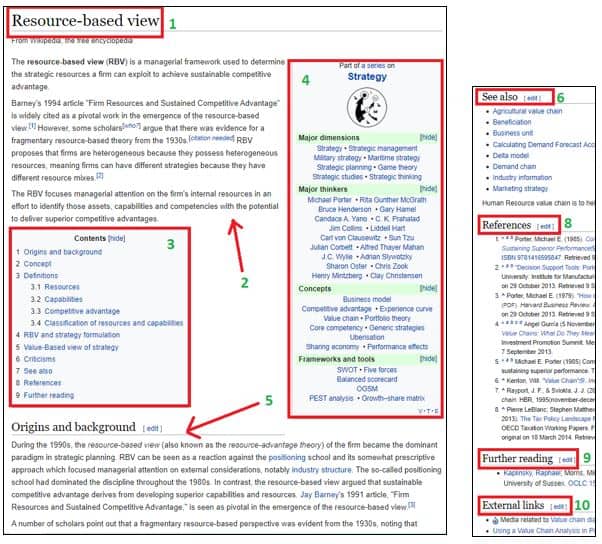
How to use Wikipedia for Academic Research?
Step 1: Scan Wikipedia articles related to your topic and gather all the relevant points.
Step 2: Make a note of in-text citations given against your points, as well as the list of references at the end of the Wikipedia article.
Step 3: Search Google Scholar for these citations using the ‘author name’, ‘date’ and ‘title’ noted from the Wikipedia article.
Step 4: Copy and paste the citations from Google Scholar into your bibliography, in the format required by your university.
For further clarification of these steps on how to use Wikipedia for academic research, read the detailed breakdown of each step below. You can also have a look at our guide on the basic rules of academic writing to re-familiarize yourself before you get started on your assignment.
Detailed guide on using Wikipedia for academic research with credible references
1. Scan Wikipedia articles related to your topic and gather all the relevant points.
As the first step to academic research, Wikipedia can provide all the background and general information you need to get started, especially if the topic is new and unfamiliar to you. After all, it is an encyclopedia at the end of the day.
You can identify pointers for your research by looking at the components of a Wikipedia page.
- The broad title (1) and the contents (3) can give you clarity on the topic and sub-topics to cover in your assignment, allowing you to map out an outline of your main themes.
- By further reading the introduction (2) and description (4), you can familiarize yourself on the basics and background of the topic.
- Using the contents section (3), you can quickly switch to subtopics within your research, and get a detailed narrative of each (5), which can help further narrowing down the scope of your topic.
2. Make a note of in-text citations, and list of references at the end of the article
In the second step, we suggest that you pay attention to in-text citations, You should also be looking at the references at the end of the article. Although you can safely piece together ideas gathered from Wikipedia into your written research, you still need to verify the points using credible and academically-acceptable sources.
That’s why Wikipedia is a great starting point for your research. You can get the bigger picture by just browsing around. What we mean is that you should never use Wikipedia as a direct citation in your assignment. As we have already established, the reliability of Wikipedia is questionable in academic contexts. Instead, you can use a variety of high quality references that talk about the same points you got from Wikipedia.
3. Search Google Scholar for these citations using the ‘author name’, ‘date’ and ‘title’ noted from the Wikipedia article.
Where to get high quality citations for points gathered from Wikipedia? Why Google of course, along with Wikipedia itself. Just pay closer attention to the numbered reference citations embedded throughout the Wikipedia article (see Image). The list of references are numbered and given at the end of the article for further research. However, please choose your citations from Wikipedia wisely. This means, stay clear of points drawing from poor references, including:
- Websites
- Blogs
- Social media posts
- Press releases
- Tabloids
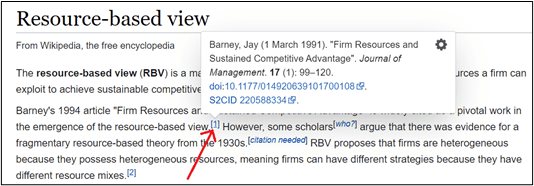
Instead, look for references of papers published in reputable journals, books published by respected publishers, articles from mainstream newspapers, etc. You should also make sure to assess the credibility of these sources by following the guide that we mentioned earlier.
Once you’ve made a list of credible academic references, you can search for these on Google Scholar. This may give you snippets or abstracts of the paper, or if you’re lucky, you can even get full-text PDF versions to read through. Alternatively, you can also identify keywords for your topic by skimming through relevant Wikipedia articles. You can then search for these keywords on Google Scholar to identify credible papers published in reputable journals.
Note: Points taken from Wikipedia without a verifiable citation must be rejected. They should not be used in your assignment, as this can lower the quality of your research.
4. Copy and paste the citations from Google Scholar into your bibliography, in the format required by your university.
Once you have a list of credible references, you can safely extract citations of these sources from Google Scholar. This is done by clicking on the quotes symbol (“) under the search result. This will give you the full reference to the article (see Image) – you can simply copy and paste this into your reference list in the required format (i.e. APA, MLA, Harvard and so on), and repeat the process with new keywords.
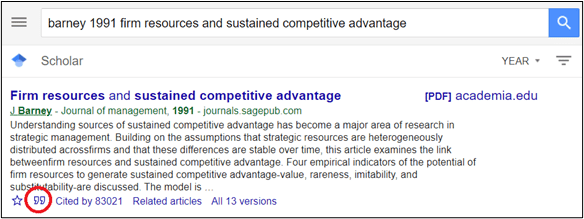
Following these steps can drastically improve the quality of your paper. You would not only have good points now, but you should also have decent references to back them up.
We hope we have given you have a comprehensive on how you can use Wikipedia as a reliable source for academic research. Just make that sure that you don’t make the rookie mistake of referencing it directly!

